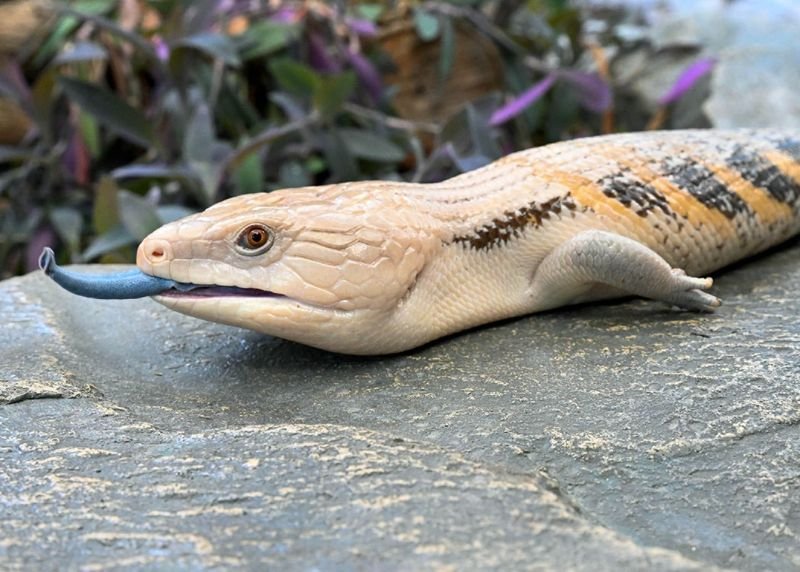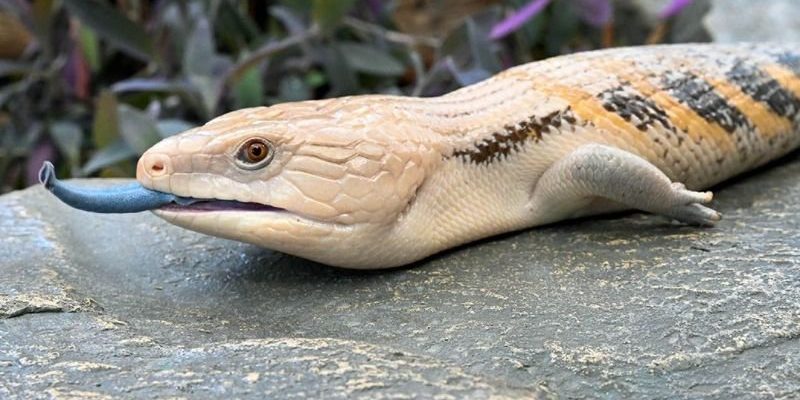
These lizards are native to Australia and New Guinea, but they’ve found their way into the hearts of pet lovers worldwide. Trust me; understanding these little guys is more exciting than it sounds! Whether you’re a budding herpetologist or just curious about this unique species, I’ve got a rundown of ten things you probably didn’t know about the blue-tongue skink. Let’s dive in!
1. Their Blue Tongue is a Warning Sign
You’re probably scratching your head wondering why on Earth a lizard would flash its tongue. Here’s the thing: when threatened, a blue-tongue skink will open its mouth wide to reveal that vivid blue tongue. It’s not just for show! This act serves as a warning to potential predators. Think of it like a stop sign—bright and bold.
By displaying this stunning blue, the skink signals danger, often startling the predator. If you’ve ever seen a cat puff up to look bigger when scared, it’s a similar concept. In many ways, the blue-tongue skink is like a small, colorful alarm bell in the wild.
2. They Come in Different Species
Surprisingly, there are several species of blue-tongue skinks, each with its unique charm. The most well-known include the Eastern blue-tongue, Northern blue-tongue, and Southern blue-tongue.
While they share the eye-catching blue tongue, their sizes and shades vary. For instance, Eastern blue-tongue skinks can grow up to 24 inches long, while others might be smaller. Imagine meeting different characters at a party; they all have their quirks but bond over that flashy blue tongue!
3. They Have a Unique Habit of Playing Dead
If you think about classic survival tactics, you might imagine animals that run or fight. Blue-tongue skinks have a fascinating twist on that idea: they sometimes play dead when threatened. This behavior, known as thanatosis, involves them flipping onto their backs and lying still, making them look unappetizing to would-be predators.
Picture this: you see a little skink suddenly flop over. At first, it seems dramatic, but it’s all part of a clever survival strategy. By playing dead, they hope the threat will lose interest and move on.
4. They’re Not Great Climbers
While lizards often dart up trees or walls, blue-tongue skinks are more ground-dwelling creatures. Their bodies are built for life on solid ground rather than scaling heights. If you’ve seen one attempt to climb, you might notice it’s a bit clumsy.
This isn’t a bad thing, though! Their preference for ground life allows them to thrive in a variety of habitats, including woodlands, grasslands, and even gardens. They’re like the friendly neighbors of the reptile world, enjoying the comfort of their base while others are scaling cliffs.
5. They’re Herbivorous… Mostly
You might assume that since they’re reptiles, blue-tongue skinks are strict carnivores. Not so fast! These skinks have a varied diet that includes fruits, vegetables, and insects. Think of them as the omnivores of the lizard world.
Their love for fresh veggies makes them unique compared to many other lizards. If you ever find yourself in a pet store, you might see owners bringing home greens, not just bugs, for their blue-tongue skinks. They appreciate a colorful plate, just like we do!
6. They Can Live for a Long Time
If you’re considering adopting a blue-tongue skink, you might be surprised by their lifespan. These skinks can live anywhere from 15 to 20 years in captivity with proper care. That’s a long-term commitment!
Imagine having a pet that essentially turns into a companion for your teenage years. This longevity means you’ll need to provide a stable environment, a great diet, and lots of love. They’re not just pets; they become part of the family.
7. They Have Strong Personalities
Ever met a pet that has a big personality? Blue-tongue skinks are no exception. They’re known to be friendly and curious, often enjoying interaction with their human companions.
Some owners even describe them as affectionate. It’s not uncommon for a skink to recognize its owner and respond with curiosity rather than fear. They might even curl up in your lap! Imagine having a small lizard buddy that enjoys hanging out with you while watching TV.
8. Their Habitat is Key to Their Health
Providing the right environment is crucial for your blue-tongue skink. They need a habitat that mimics their natural surroundings, including places to hide and bask. This means including elements like logs, rocks, and plants in their enclosure.
The temperature should also be just right—warm enough for basking but cool enough for them to escape the heat. A comfortable, enriched environment leads to a happy, healthy skink, ready to show off that blue tongue!
9. They’re Slow Movers
Unlike some speedy reptiles, blue-tongue skinks are generally slow movers. They take their time exploring their surroundings, which is part of their charm. Their laid-back nature can be amusing to watch.
Imagine a little skink just meandering along, stopping to check out a rock or a leaf. They may not be the fastest in the animal kingdom, but their calm demeanor makes them endearing.
10. They Love to Breathe and Relax!
It’s not all about defense and survival; blue-tongue skinks enjoy leisurely activities too! In the wild, you’ll often find them basking in the sun to soak up warmth. This not only helps them regulate their body temperature but also gives them a chance to relax and absorb nutrients from their food.
In captivity, it’s essential to mimic this behavior. Providing a warm basking spot will ensure your skink maintains its health and energy. Think of it like a cozy sunbathing session—everyone could use a little relaxation now and then!
In conclusion, blue-tongue skinks are fascinating creatures full of surprises. From their vibrant blue tongues to their unique behaviors, they offer a beautiful glimpse into the reptile world. Whether you’re considering one as a pet or you’re just intrigued by their quirks, there’s so much to learn about these charming lizards. They remind us that nature is not only diverse but also endlessly captivating. You might find yourself smiling every time you think about that little skink with the big personality and bright blue tongue!

